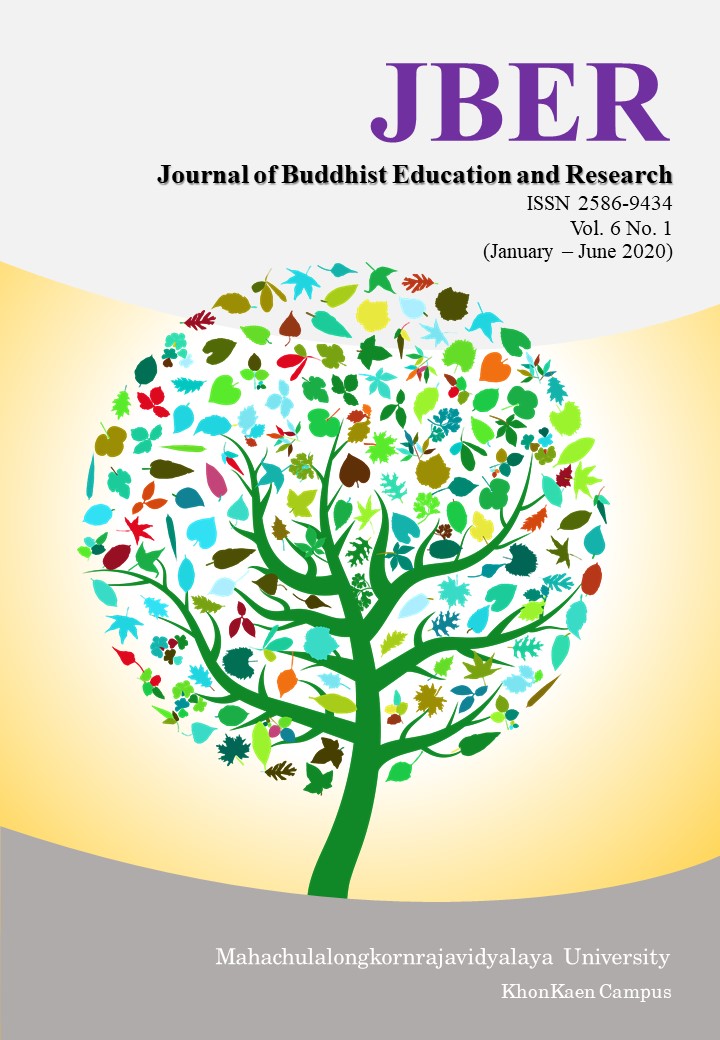A STUDY OF THE INTEGRATIVE BUDDHIST LEARNING MANAGEMENT MODEL OF THE MORAL TEACHING MONKS IN SCHOOLS IN KHON KAEN PROVINCE
Keywords:
The Integrative Buddhist Learning Management Model, The Moral Teaching Monks.Abstract
The aims of this research were: to study the conditions and the models, and present the model of the integrative Buddhist learning management of moral teaching monks in schools in Khon Kaen province. The sample group was 255 moral teaching monks in schools in Khon Kaen province selected by using proportion estimation methods based on the table of Krejcie & Morgan. The target group consisted of 10 of executives and moral teaching monks in the morality teaching schools. This study was conducted by means of a mix research methodology primarily focusing on the quantitative one by using the questionnaire and using qualitative research as supplementary information by using the structured in-depth interview. The data analysis method was a descriptive analysis. The statistics used in the data analysis were: Frequency, Percentage, Mean and Standard Deviation.
The research results were as follows:
1) The conditions of the integrative Buddhist learning management of moral teaching monks in schools in Khon Kaen province in overall and in each aspect were rated at a very good level of practice. The studied aspects were rated in this descending order: 1) integrated Buddhist learning plan; 2) integrated Buddhist teaching by the threefold training principles; 3) learning media and learning resources; 4) organizing learning activities and 5) measurement and evaluation.
2) The model of the integrative Buddhist learning management of moral teaching monks in schools in Khon Kaen province can be summarized as follows. 1) The integrated Buddhist learning management plan: the curriculum has been adjusted to be in accordance with the problems with a concrete learning plan and a teaching manual. 2) Learning activities: there are interesting and modern activities, integrated with modern science, with interventions of morality and ethics in teaching and learning. 3) Learning media and learning resources: there is technology development in teaching and learning to be consistent with the subject matter. 4) Measurement and evaluation: there are assessments that are in accordance with the content. 5) Buddhist teaching by integrating the principles of the threefold training: the dhammas are integrated into the teaching and learning management in order for learners to be able to adapt to everyday life.
3) The integrative Buddhist learning management of moral teaching monks in schools in Khon Kaen province has a learning management plan that is consistent with the learning unit. There is a complete learning element, creating concepts with standardized learning. The learning content is appropriate for the duration, emphasizing the use of knowledge in creative analytical thinking. Learning activities are divided into steps as appropriate for the content of each level. It emphasizes activities that are diverse and can be adapted for use in daily life. It promotes students’ thinking processes with morality and ethics; and desirable characteristics. It brings modern learning media to integrate into teaching and learning. There are various suitable methods of measurement and evaluation. There are the assessment criteria that are fair, transparent and consistent with the learning standards integrated with the dhamma principles for students to learn, practice and used in daily life.
References
จำรัส บุดดาพงษ์ และคณะ. (2561). บทบาทของครูพระสอนศีลธรรมในการแก้ไขปัญหายาเสพติดด้วยการสร้างจิตสำนึกแก่เยาวชนในสถานศึกษาภาคตะวันออกเฉียงเหนือ. วารสารมนุษยศาสตร์และสังคมศาสตร์ มหาวิทยาลัยราชภัฏอุบลราชธานี. 9(2), 201-211.
พระกิตติศักดิ์ ธีรปญฺโญฺ (เจริญสุข). (2561). บทบาทของพระสอนศีลธรรมในการจัดการเรียนการสอนวิชาพระพุทธศาสนา อำเภอบางน้ำเปรี้ยว จังหวัดฉะเชิงเทรา. ปริญญาพุทธศาสตรมหาบัณฑิต สาขาวิชาการสอนสังคมศึกษา. บัณฑิตวิทยาลัย มหาวิทยาลัยมหาจุฬาลงกรณราชวิทยาลัย.
พระครูโพธิสุวรรณคุณ (มานพ จนฺทาโภ). (2559). บทบาทของพระสอนศีลธรรมในโรงเรียนที่มีต่อการจัดการเรียนการสอนในจังหวัดสุพรรณบุรี. วารสารสมาคมศิษย์เก่า มหาวิทยาลัยมหาจุฬาลงกรณราชวิทยาลัย. 5(1), 31-47.
พระปลัดวรรธนา ญาณวโร (สุวรรณเพ็ง). (2562). การจัดการเรียนรู้วิชาพระพุทธศาสนาของครูผู้สอนโดยใช้หลักสาราณียธรรม 6 ของโรงเรียนพระปริยัติธรรม แผนกสามัญศึกษา จังหวัดกาฬสินธุ์. พุทธศาสตรมหาบัณฑิต สาขาวิชาการสอนสังคม.บัณฑิตวิทยาลัย มหาวิทยาลัยมหาจุฬาลงกรณราชวิทยาลัย.
พระวสันต์ ธีรวโร (เกษงาม). (2562). การศึกษาสภาพการใช้สื่อเทคโนโลยีสารสนเทศในการจัดการเรียนการสอนรายวิชาพระพุทธศาสนาของครูในโรงเรียน สังกัดสำนักงานเขตพื้นที่การศึกษามัธยมศึกษาเขต 19. พุทธศาสตรมหาบัณฑิต สาขาวิชาการสอนสังคม. บัณฑิตวิทยาลัย มหาวิทยาลัยมหาจุฬาลงกรณราชวิทยาลัย.
ราชกิจจานุเบกษา. (2542). พระราชบัญญัติการศึกษาแห่งชาติ พ.ศ. 2542. สืบค้นเมื่อ 15 มี.ค. 2562. จาก http://www.ratchakitcha.soc.go.th/DATA/PDF/2542/A/074/1.PDF.
สุมน อมรวิวัฒน์. (2544). หลักบูรณาการทางการศึกษาตามนัยแห่งพุทธธรรม. กรุงเทพมหานคร : สำนักพิมพ์มหาวิทยาลัยสุโขทัยธรรมาธิราช.
เสน่ห์ สีกาวี และ บรรจบ บรรณรุจิ. (2560). พัฒนากระบวนการเรียนรูเชิงพุทธบูรณาการ. วารสารสันติศึกษาปริทรรศน์ มจร. 5(3), 278-289.





